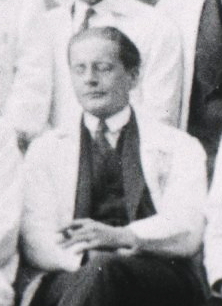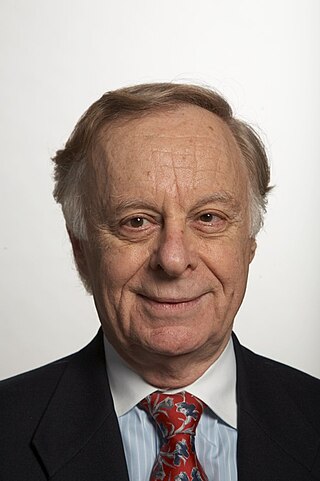Richard A. Isay was an American psychiatrist, psychoanalyst, author and gay activist. He was a professor of psychiatry at Weill Cornell Medical College and a faculty member of the Columbia University Center for Psychoanalytic Training and Research. Isay is considered a pioneer who changed the way that psychoanalysts view homosexuality.

Heinz Hartmann, was an Austrian psychiatrist and psychoanalyst. He is considered one of the founders and principal representatives of ego psychology.

The American Psychoanalytic Association (APsA) is an association of psychoanalysts in the United States. APsA serves as a scientific and professional organization with a focus on education, research, and membership development.
Otto Fenichel was a psychoanalyst of the so-called "second generation". He was born into a prominent family of Jewish lawyers.
Nicholas Trigant Burrow was an American psychoanalyst, psychiatrist, psychologist, and, alongside Joseph H. Pratt and Paul Schilder, founder of group analysis in the United States. He was the inventor of the concept of neurodynamics.
Ralph R. Greenson was a prominent American psychiatrist and psychoanalyst. Greenson is famous for being Marilyn Monroe's psychiatrist. He was the basis for Leo Rosten's 1963 novel, Captain Newman, M.D. The book was later made into a movie starring Gregory Peck as Greenson's character.
Judd Marmor was an American psychoanalyst and psychiatrist known for his role in removing homosexuality from the American Psychiatric Association's Diagnostic and Statistical Manual of Mental Disorders.
The Boston Psychoanalytic Society and Institute (BPSI) is a psychoanalytic research, training, education facility that is affiliated with the American Psychoanalytic Association and the International Psychoanalytic Association. There were no psychoanalytic societies devoted to Sigmund Freud in Boston prior to his visit to Worcester, Massachusetts in 1909, though after 1909 there were individuals interested in Freud's writings, including James Jackson Putnam, L. Eugene Emerson, Isador Coriat, William Healy, and Augusta Bronner.
The San Francisco Center for Psychoanalysis, formerly the San Francisco Psychoanalytic Society and Institute is a facility for psychoanalytic research, training, and education located on 2420 Sutter St. in San Francisco, California.

Ernst Simmel was a German-American neurologist and psychoanalyst.

Henry Zvi Lothane is a Polish-born American psychiatrist, psychoanalyst, educator and author. Lothane is currently Clinical Professor at Icahn School of Medicine at Mount Sinai, New York City, specializing in the area of psychotherapy. He is the author of some eighty scholarly articles and reviews on various topics in psychiatry, psychoanalysis and the history of psychotherapy, as well as the author of a book on the famous Schreber case, entitled In Defense of Schreber: Soul Murder and Psychiatry. In Defense of Schreber examines the life and work of Daniel Paul Schreber against the background of 19th and early 20th century psychiatry and psychoanalysis.
Martin Grotjahn was a German-born American psychoanalyst who was known for his contributions to the field of psychoanalysis. He was the son of doctor Alfred Grotjahn and was born in Berlin, Germany.
Psychoanalytic institutes and societies in the United States are often linked together, though a distinction may be made between the functions of the institutes and the societies. Some local psychoanalytic organizations have both words in their title while others have only one or the other.
James S. Grotstein was a psychiatrist and psychoanalyst, known for his role in the popularization and explication of the work of Melanie Klein and Wilfred Bion. Among other topics, he expanded on Klein's notions of the paranoid-schizoid and depressive positions. His roles in psychoanalytic organizations included serving as North American Vice President of the International Psychoanalytical Association (IPA), and on the editorial board of the International Journal of Psychoanalysis (IJP).
The Psychoanalytic Center of California (PCC) is a psychoanalytic institute in Los Angeles, California, that emphasizes psychoanalytic approaches based on the work of Melanie Klein, Wilfred Bion, the British Object Relations School, and other theorists in the Kleinian traditions. It is affiliated with the International Psychoanalytic Association and has been recognized as a component society since 1993.
James Gooch was an American psychiatrist and psychoanalyst influential in promoting the ideas of Melanie Klein, Wilfred Bion, and the British Object Relations theorists in Southern California in the 1980s and 1990s. He was chair of the Department of Psychoanalysis at the California Graduate Institute, an independent professional school for psychologists, and during 1984-1990 he was founding president of the Psychoanalytic Center of California (PCC), a Kleinian-oriented psychoanalytic institute in Los Angeles. He was also a founding member of The Confederation of Independent Psychoanalytic Societies and served for eight years as the North American Representative to the Board of the IPA International Psychoanalytic Association.
The Greater Kansas City and Topeka Psychoanalytic Center and Institute, also known as the Greater Kansas City Psychoanalytic Center and Institute (GKCPI), is a psychoanalytic center in Kansas City, Missouri, that comprises several interrelated organizations. Currently these are the Kansas City Psychoanalytic Foundation, the Greater Kansas City and Topeka Psychoanalytic Center (GKCTPC), and the Greater Kansas City Psychoanalytic Institute (GKCPI), also known as the Foundation, the center, and the institute. In the early 2000s, the Greater Kansas City Psychoanalytic Institute merged with the older Topeka Psychoanalytic Society.
Martha J Kirkpatrick was an American psychoanalyst and clinical professor of psychiatry at the University of California, Los Angeles. She was also vice president of the American Psychiatric Association. She was known for pioneering work on lesbian parents, providing evidence that their children were not psychologically harmed by growing up with same-sex parents. She also published extensively on the psychology of women in regard to relationships, divorce, and aging.
May E. (Ginsberg) Romm was a Jewish American psychiatrist, Freudian psychoanalyst, educator, and author. After graduating and establishing a practice in New York, Romm moved to Hollywood in 1938 and influenced psychoanalytic infusion in American film. She was an expert on fetishism and exhibitionism and considered the most influential Hollywood Freudian of the mid-twentieth century.



